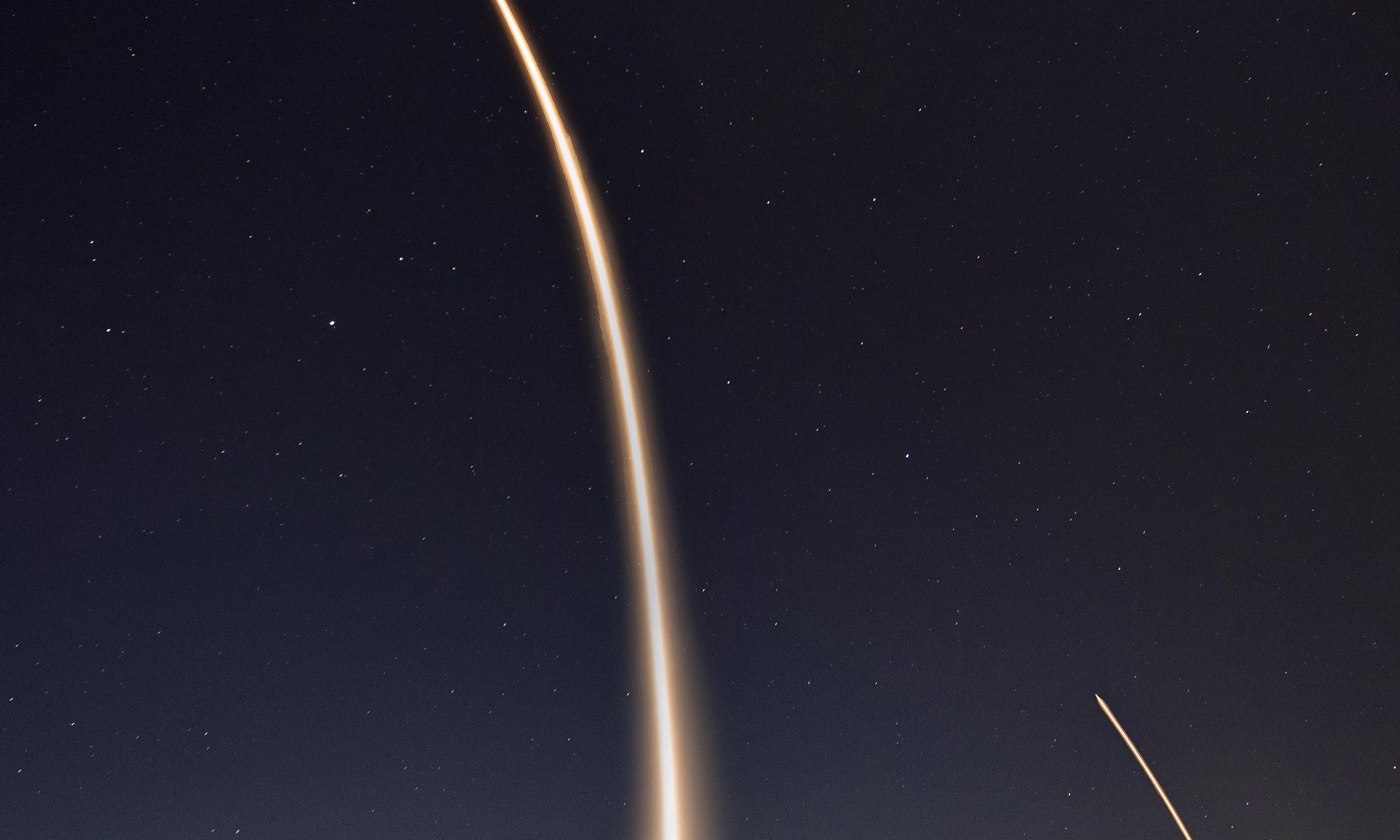On Friday, March 6th, as part of the company’s 20th Commercial Resupply Services (CRS-20) mission, SpaceX launched a Dragon 1 capsule destined for the International Space Station (ISS). The mission involved the transport of supplies, as well as materials related to the more than 250 science investigations taking place aboard the ISS. More than that, it represented a milestone for the aerospace manufacturer.
Continue reading “SpaceX Launches its Last Dragon 1 Mission to the ISS”Spaceflight Stories Expected for 2020
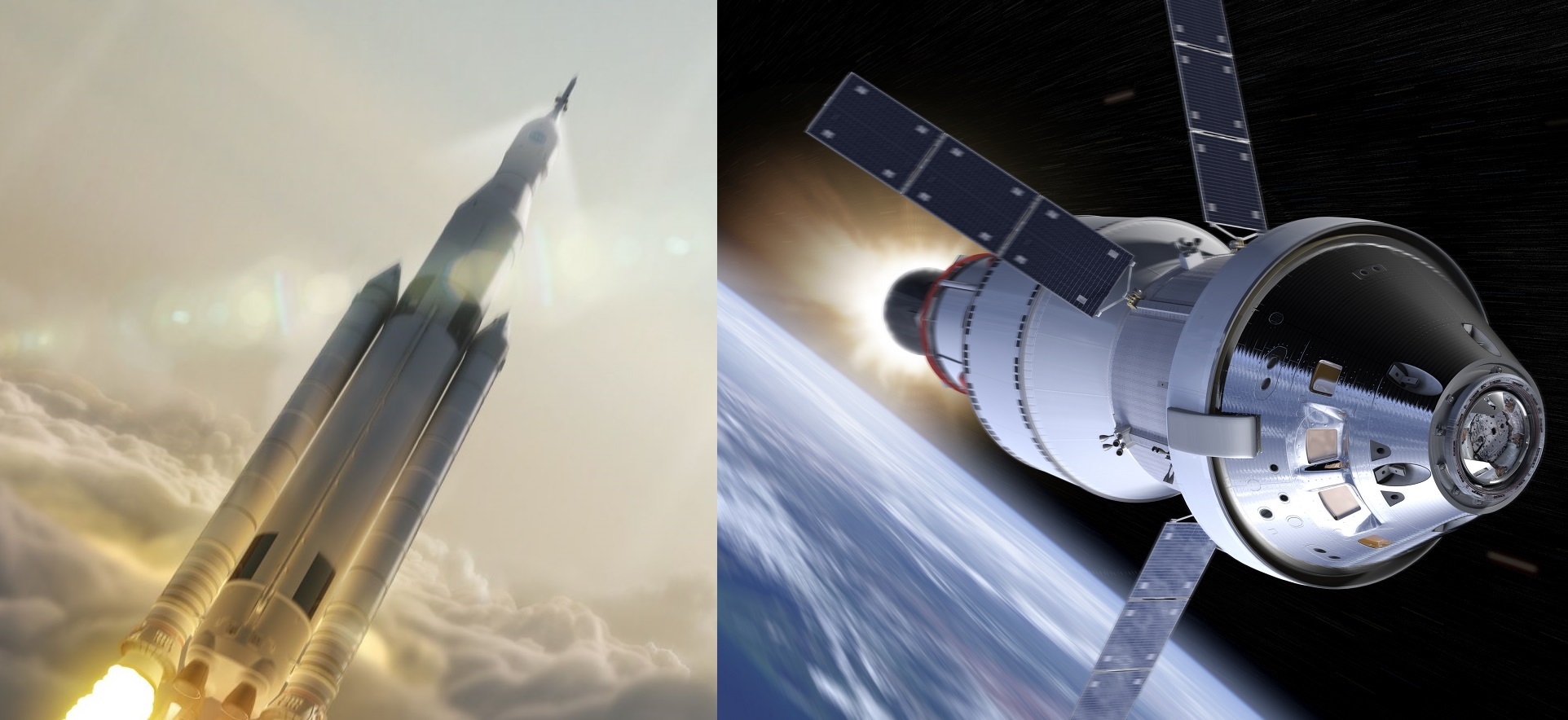
The year two thousand and twenty is almost upon us. And as always, space agencies and aerospace companies all around the world are preparing to spend the coming year accomplishing a long list of missions and developments. Between NASA, the ESA, China, SpaceX, and others, there are enough plans to impress even the most curmudgeonly of space enthusiasts.
Continue reading “Spaceflight Stories Expected for 2020”NASA Estimates SpaceX 2018 Mars Mission Will Cost Only $300 Million

Ever since Musk founded SpaceX is 2002, with the intention of eventually colonizing Mars, every move he has made has been the subject of attention. And for the past two years, a great deal of this attention has been focused specifically on the development of the Falcon Heavy rocket and the Dragon 2 capsule – the components with which Musk hopes to mount a lander mission to Mars in 2018.
Among other things, there is much speculation about how much this is going to cost. Given that one of SpaceX’s guiding principles is making space exploration cost-effective, just how much money is Musk hoping to spend on this important step towards a crewed mission? As it turns out, NASA produced some estimates at a recent meeting, which indicated that SpaceX is spending over $300 million on its proposed Mars mission.
These estimates were given during a NASA Advisory Council meeting, which took place in Cleveland on July 26th between members of the technology committee. During the course of the meeting, James L. Reuter – the Deputy Associate Administrator for Programs at NASA’s Space Technology Mission Directorate – provided an overview of NASA’s agreement with SpaceX, which was signed in December of 2014 and updated this past April.
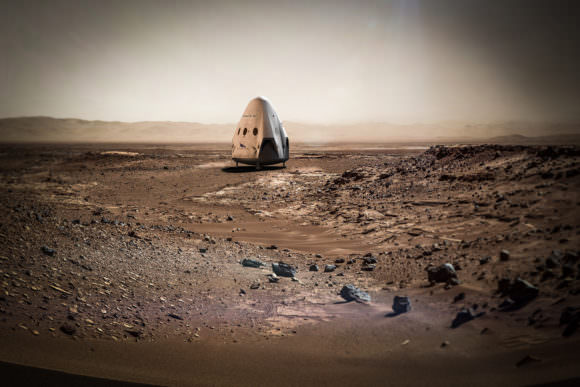
In accordance with this agreement, NASA will be providing support for the company’s plan to send an uncrewed Dragon 2 capsule (named “Red Dragon”) to Mars by May of 2018. Intrinsic to this mission is the plan to conduct a propulsive landing on Mars, which would test the Dragon 2‘s SuperDraco Descent Landing capability. Another key feature of this mission will involve using the Falcon Heavy to deploy the capsule.
The terms of this agreement do not involve the transfer of funds, but entails active collaboration that would be to the benefit parties. As Reuters indicated in his presentation, which NASA’s Office of Communications shared with Universe Today via email (and will be available on the STMD’s NASA page soon):
“Building on an existing no-funds-exchanged collaboration with SpaceX, NASA is providing technical support for the firm’s plan to attempt to land an uncrewed Dragon 2 spacecraft on Mars. This collaboration could provide valuable entry, descent and landing (EDL) data to NASA for our journey to Mars, while providing support to American industry. We have similar agreements with dozens of U.S. commercial, government, and non-profit partners.”
Further to this agreement is NASA’s commitment to a budget of $32 million over the next four years, the timetable of which were partially-illustrated in the presentation: “NASA will contribute existing agency resources already dedicated to [Entry, Descent, Landing] work, with an estimated value of approximately $32M over four years with approximately $6M in [Fiscal Year] 2016.”
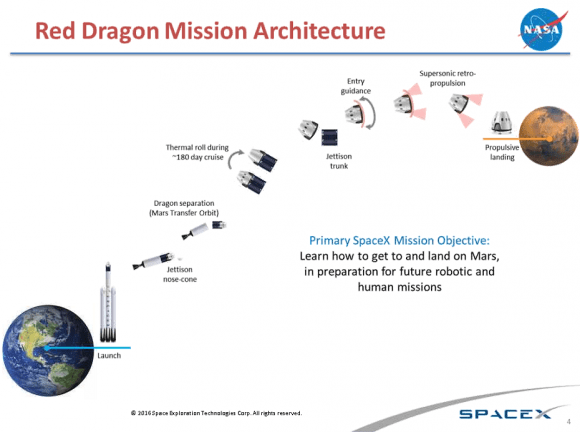
According to Article 21 of the Space Act Agreement between NASA and SpaceX, this will include providing SpaceX with: “Deep space communications and telemetry; Deep space navigation and trajectory design; Entry, descent and landing system analysis and engineering support; Mars entry aerodynamic and aerothermal database development; General interplanetary mission advice and hardware consultation; and planetary protection consultation and advice.”
For their part, SpaceX has not yet disclosed how much their Martian mission plan will cost. But according to Jeff Foust of SpaceNews, Reuter provided a basic estimate of about $300 million based on a 10 to 1 assessment of NASA’s own financial commitment: “They did talk to us about a 10-to-1 arrangement in terms of cost: theirs 10, ours 1,” said Reuter. “I think that’s in the ballpark.”
As for why NASA has chosen to help SpaceX make this mission happen, this was also spelled out in the course of the meeting. According to Reuter’s presentation: “NASA conducted a fairly high-level technical feasibility assessment and determined there is a reasonable likelihood of mission success that would be enhanced with the addition of NASA’s technical expertise.”
Such a mission would provide NASA with valuable landing data, which would prove very useful when mounting its crewed mission in the 2030s. Other items discussed included NASA-SpaceX collaborative activities for the remainder of 2016 – which involved a “[f]ocus on system design, based heavily on Dragon 2 version used for ISS crew and cargo transportation”.
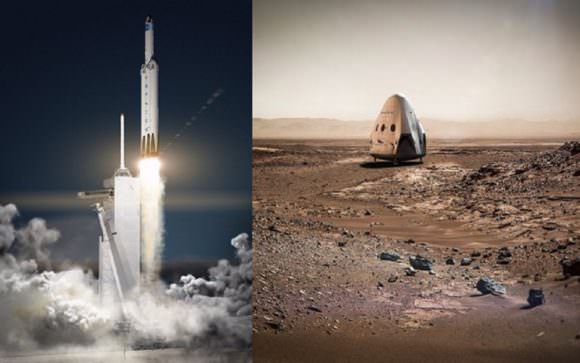
It was also made clear that the Falcon Heavy, which SpaceX is close to completing, will serve as the launch vehicle. SpaceX intends to conduct its first flight test (Falcon Heavy Demo Flight 1) of the heavy-lifter in December of 2016. Three more test flights are scheduled to take place between 2017 and the launch of the Mars lander mission, which is still scheduled for May of 2018.
In addition to helping NASA prepare for its mission to the Red Planet, SpaceX’s progress with both the Falcon Heavy and Dragon 2 are also crucial to Musk’s long-term plan for a crewed mission to Mars – the architecture of which has yet to be announced. They are also extremely important in the development of the Mars Colonial Transporter, which Musk plans to use to create a permanent settlement on Mars.
And while $300 million is just a ballpark estimate at this juncture, it is clear that SpaceX will have to commit considerable resources to the enterprise. What’s more, people must keep in mind that this would be merely the first in a series of major commitments that the company will have to make in order to mount a crewed mission by 2024, to say nothing of building a Martian colony!
In the meantime, be sure to check out this animation of the Crew Dragon in flight:
Uh, We’re Going To Need A Bigger Landing Pad
Since 2000, Elon Musk been moving forward with his vision of a fleet of reusable rockets, ones that will restore domestic launch capability to the US and drastically reduce the cost of space launches. The largest rocket in this fleet is the Falcon Heavy, a variant of the Falcon 9 that uses the same rocket core, with two additional boosters that derived from the Falcon 9 first stage. When it lifts off later this year, it will be the most operational powerful rocket in the world.
More than that, SpaceX intends to make all three components of the rocket fully recoverable. This in turn will mean mean that the company is going to need some additional landing pads to recover them all. As such, the company recently announced that it is seeking federal permission to create second and third landing zones for their incoming rockets on Florida’s Space Coast.
The announcement came on Monday, July 18th, during a press conference at their facility at the Cape Canaveral Air Force Station. As they were quoted as saying by the Orlando Sentinel:
“SpaceX expects to fly Falcon Heavy for the first time later this year. We are also seeking regulatory approval to build two additional landing pads at Cape Canaveral Air Force Station. We hope to recover all three Falcon Heavy rockets, though initially we may attempt drone ship landings [at sea].”
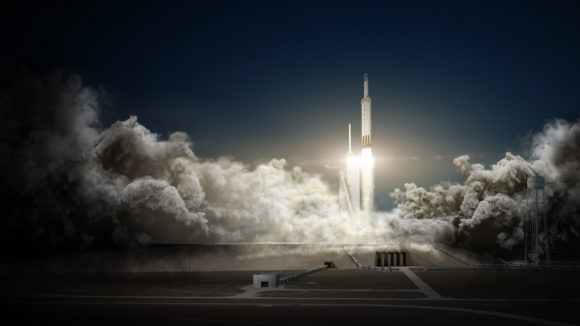
At present, SpaceX relies on both drone ships and their landing site at Cape Canaveral to recover rocket boosters after they return to Earth. Which option they have used depended on how high and how far downrange the rockets traveled. But with this latest announcement, they are seeking to recover all three boosters used in a single Falcon Heavy launch, which could prove to be essential down the road.
Since December, SpaceX has managed to successfully recover five Falcon 9 rockets, both at sea and on land. In fact, the announcement of their intentions to expand their landing facilities on Monday came shortly after a spent Falcon 9 returned to the company’s landing site, shortly after deploying over 2268 kg (5000 lbs) of cargo into space during a nighttime launch.
But the planned launch of the Falcon Heavy – Falcon Heavy Demo Flight 1, which is scheduled to take place this coming December – is expected to break new ground. For one, it will give the private aerospace company the ability to lift over 54 metric tons (119,000 lbs) into orbit, more the twice the payload of a Delta IV Heavy – the highest capacity rocket in service at the moment.
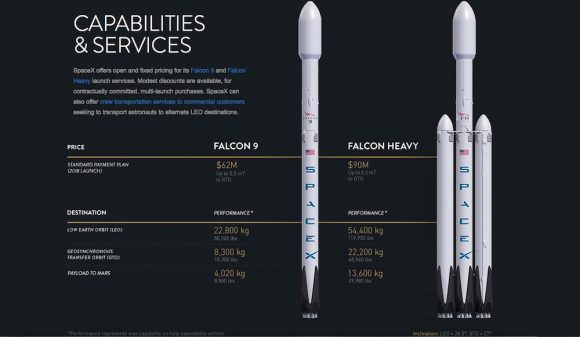
Foremost among these are Elon Musk’s plans to colonize Mars. These efforts will begin in April or May of 2018 with the launch of the Dragon 2 capsule (known as the “Red Dragon”) using a Falcon Heavy. As part of an agreement with NASA to gain more information on Mars landings, the Red Dragon will send a payload to Mars that has yet to be specified.
Beyond that, the details are a bit sketchy; but Musk has indicated that he is committed to mounting a crewed mission to Mars by 2024. And if all goes well with Demo Flight 1, SpaceX expects to follow it up with Falcon Heavy Demo Flight 2 in March of 2017. This launch will see the Falcon Heavy being tested as part of the U.S. Air Force’s Evolved Expendable Launch Vehicle (EELV) certification process.
The rocket will also be carrying some important payloads, such as The Planetary Society’s LightSail 2. This 32 square-meter (344 square-foot) craft, which consists of four ultra-thin Mylar sails, will pick up where its predecessor (the LightSail 1, which was deployed in June 2015) left off – demonstrating the viability of solar sail spacecraft.
Other payloads will include NASA’s Deep Space Atomic Clock and Green Propellant Infusion Mission (GPIM), the US Air Force’s Innovative Space-based radar Antenna Technology (ISAT) satellite, the six Constellation Observing System for Meteorology, Ionosphere and Climate (COSMIC-2) satellites, and Georgia Tech’s Prox-1 nanosatellite, which will act as the LightSail 2’s parent sattelite.
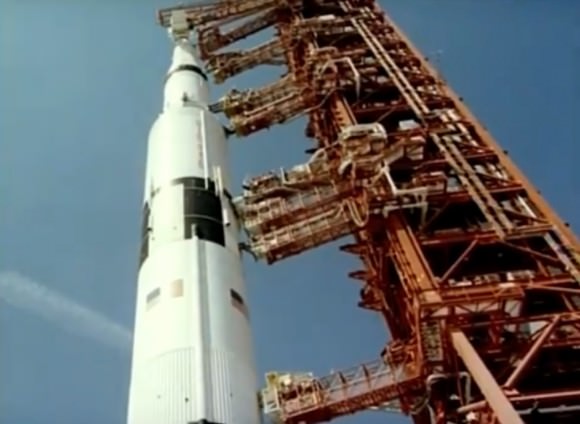
The Falcon Heavy boasts three Falcon 9 engine cores, each of which is made up of 9 Merlin rocket engines. Together, these engines generate more than 2.27 million kg (5 million pounds) of thrust at liftoff, which is the equivalent of approximately eighteen 747 aircraft. Its lift capacity is also equivalent to the weight of a fully loaded 737 jetliner, complete with passengers, crew, luggage and fuel.
The Saturn V rocket – the workhorse of the Apollo Program, and which made its last flight in 1973 – is only American rocket able to deliver more payload into orbit. This is not surprising, seeing as how the Falcon Heavy was specifically designed for a new era of space exploration, one that will see humans return to the Moon, go to Mars, and eventually explore the outer Solar System.
Fingers crossed that everything works out and the Falcon Heavy proves equal to the enterprise. The year of 2024 is coming fast and many of us are eager to see boots being put to red soil! And be sure to enjoy this animation of the Falcon Heavy in flight:
Further Reading: Orlando Sentinel
SpaceX Announces Plan to Launch Private Dragon Mission to Mars in 2018

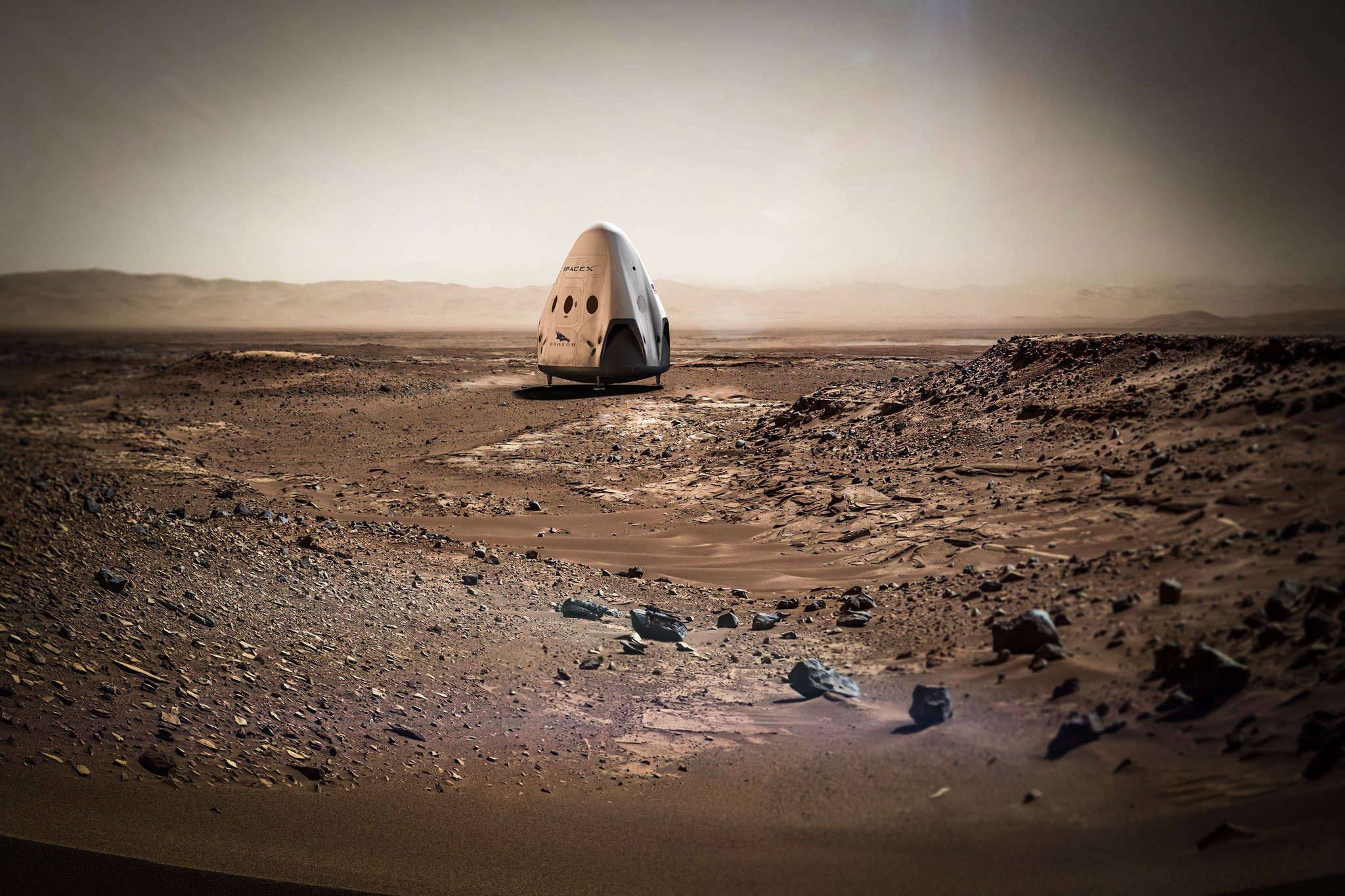
SpaceX announced plans today, April 27, for the first ever private mission to Mars which involves sending an uncrewed version of the firms Dragon spacecraft to accomplish a propulsive soft landing – and to launch it as soon as 2018 including certain technical assistance from NASA.
Under a newly signed space act agreement with NASA, the agency will provide technical support to SpaceX with respect to Mars landing technologies for the new spacecraft known as a ‘Red Dragon’ and possibly also for science activities.
“SpaceX is planning to send Dragons to Mars as early as 2018,” the company posted in a brief announcement today on Facebook and other social media about the history making endeavor.
The 2018 commercial Mars mission involves launching the ‘Red Dragon’ – also known as Dragon 2 – on the SpaceX Falcon Heavy rocket from Launch Pad 39A at NASA’s Kennedy Space Center in Florida. It’s a prelude to eventual human missions.
The Red Dragon initiative is a commercial endeavor that’s privately funded by SpaceX and does not include any funding from NASA. The agreement with NASA specifically states there is “no-exchange-of-funds.”
As of today, the identity and scope of any potential science payload is undefined and yet to be determined.
Hopefully it will include a diverse suite of exciting research instruments from NASA, or other entities, such as high powered cameras and spectrometers characterizing the Martian surface, atmosphere and environment.
SpaceX CEO and billionaire founder Elon Musk has previously stated his space exploration goals involve helping to create a Mars colony which would ultimately lead to establishing a human ‘City on Mars.’
Musk is also moving full speed ahead with his goal of radically slashing the cost of access to space by recovering a pair of SpaceX Falcon 9 first stage boosters via successful upright propulsive landings on land and at sea – earlier this month and in Dec. 2015.

The 2018 liftoff campaign marks a significant step towards fulfilling Musk’s Red Planet vision. But we’ll have to wait another 5 months for concrete details.
“Red Dragon missions to Mars will also help inform the overall Mars colonization architecture that SpaceX will reveal later this year,” SpaceX noted.
Musk plans to reveal the details of the Mars colonization architecture later this year at the International Astronautical Congress (IAC) being held in Guadalajara, Mexico from September 26 to 30, 2016.
Landing on Mars is not easy. To date only NASA has successfully soft landed probes on Mars that returned significant volumes of useful science data.
In the meantime a few details about the SpaceX Red Dragon have emerged.
The main goal is to propulsively land something 5-10 times the size of anything previously landed before.
“These missions will help demonstrate the technologies needed to land large payloads propulsively on Mars,” SpaceX further posted.
NASA’s 1 ton Curiosity rover is the heaviest spaceship to touchdown on the Red Planet to date.
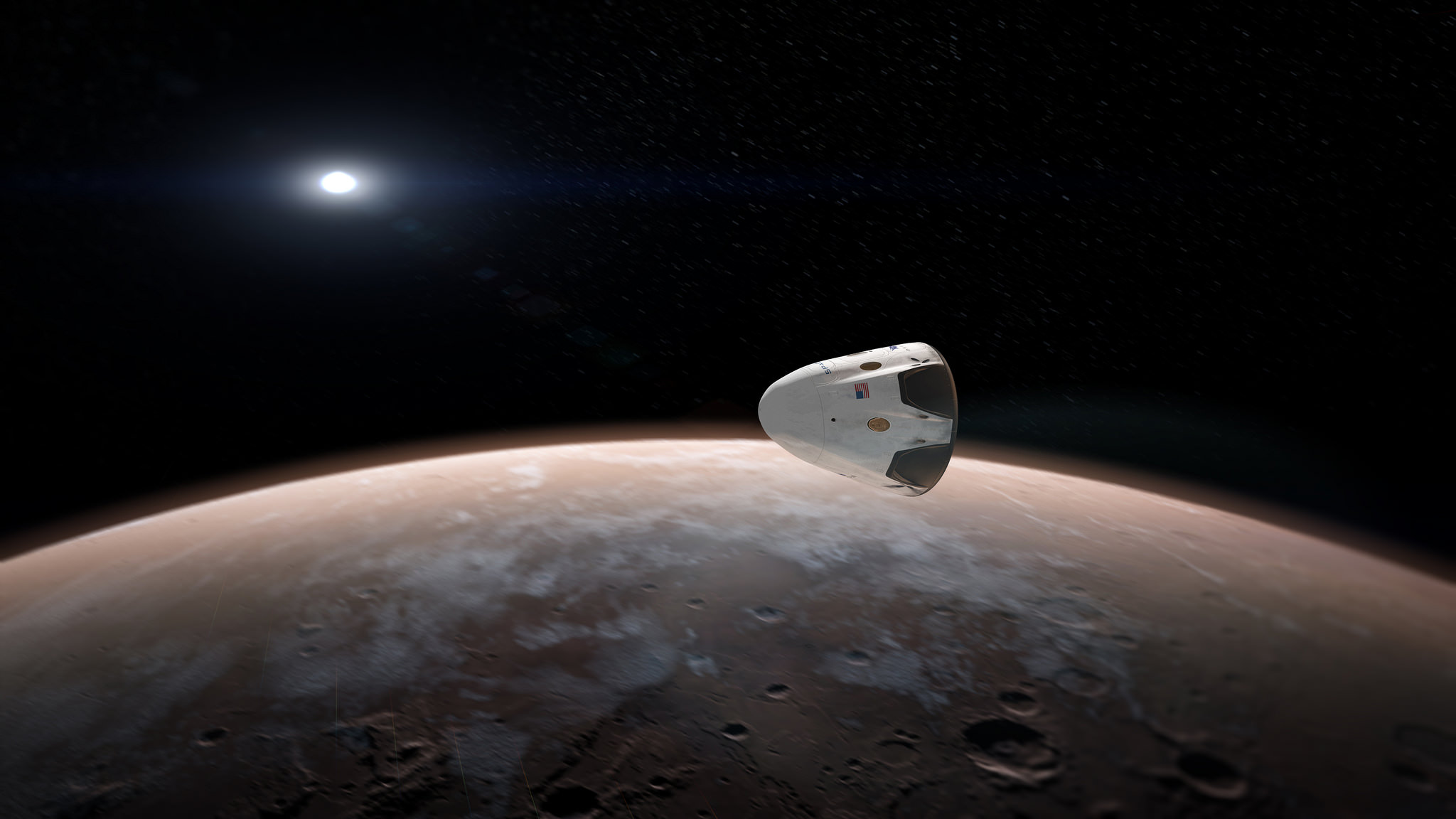
As part of NASA’s agency wide goal to send American astronauts on a human ‘Journey to Mars’ in the 2030s, NASA will work with SpaceX on some aspects of the Red Dragon initiative to further the agency’s efforts.
According to an amended space act agreement signed yesterday jointly by NASA and SpaceX officials – that originally dates back to November 2014 – this mainly involves technical support from NASA and exchanging entry, descent and landing (EDL) technology, deep space communications, telemetry and navigation support, hardware advice, and interplanetary mission and planetary protection advice and consultation.
“We’re particularly excited about an upcoming SpaceX project that would build upon a current “no-exchange-of-funds” agreement we have with the company,” NASA Deputy Administrator Dava Newman wrote in a NASA blog post today.
“In exchange for Martian entry, descent, and landing data from SpaceX, NASA will offer technical support for the firm’s plan to attempt to land an uncrewed Dragon 2 spacecraft on Mars.”
“This collaboration could provide valuable entry, descent and landing data to NASA for our journey to Mars, while providing support to American industry,” NASA noted in a statement.
The amended agreement with NASA also makes mention of sharing “Mars Science Data.”
As of today, the identity, scope and weight of any potential science payload is undefined and yet to be determined.
Perhaps it could involve a suite of science instruments from NASA, or other entities, such as cameras and spectrometers characterizing various aspects of the Martian environment.
In the case of NASA, the joint agreement states that data collected with NASA assets is to be released within a period not to exceed 6 months and published where practical in scientific journals.
The Red Dragon envisioned for blastoff to the Red Planet as soon as 2018 would launch with no crew on board on a critical path finding test flight that would eventually pave the way for sending humans to Mars – and elsewhere in the solar system.
“Red Dragon Mars mission is the first test flight,” said Musk.
“Dragon 2 is designed to be able to land anywhere in the solar system.”
However, the Dragon 2 alone is far too small for a round trip mission to Mars – lasting some three years or more.
“But wouldn’t recommend transporting astronauts beyond Earth-moon region,” tweeted Musk.
“Wouldn’t be fun for longer journeys. Internal volume ~size of SUV.”
Furthermore, for crewed missions it would also have to be supplemented with additional modules for habitation, propulsion, cargo, science, communications and more. Think ‘The Martian’ movie to get a realistic idea of the complexity and time involved.
Red Dragon’s blastoff from KSC pad 39A is slated to take place during the Mars launch window opening during April and May 2018.
The inaugural liftoff of the Falcon Heavy is currently scheduled for late 2016 after several years postponement.
If all goes well, Red Dragon could travel to Mars at roughly the same time as NASA’s next Mission to Mars – namely the InSight science lander, which will study the planets deep interior with a package of seismometer and heat flow instruments.
InSight’s launch on a United Launch Alliance Atlas V is targeting a launch window that begins May 5, 2018, with a Mars landing scheduled for Nov. 26, 2018. Liftoff was delayed from this year due to a flaw in the French-built seismometer.
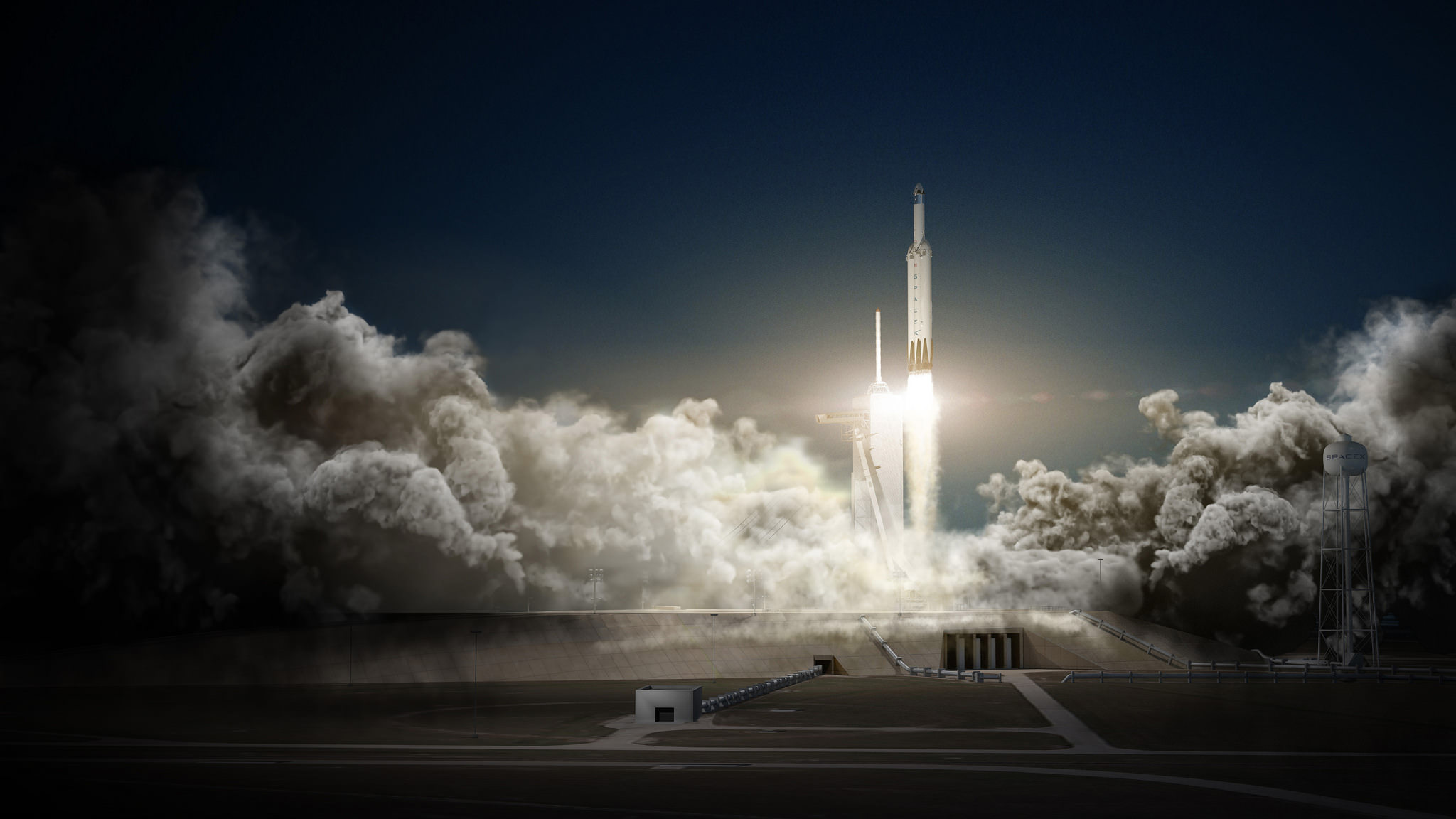
Whoever wants to land on Mars also has to factor in the relevant International treaties regarding ‘Planetary Protection’ requirements.
Wherever the possibility for life exists, the worlds space agency’s who are treaty signatories, including NASA, are bound to adhere to protocols limiting contamination by life forms from Earth.
SpaceX intends to take planetary protection seriously. Under the joint agreement, SpaceX is working with relevant NASA officials to ensure proper planetary protection procedures are followed. One of the areas of collaboration with NASA is for them to advise SpaceX in the development a Planetary Protection Plan (PPP) and assist with the implementation of a PPP including identifying existing software/tools.
Red Dragon is derived from the SpaceX crew Dragon vehicle currently being developed under contract for NASA’s Commercial Crew Program (CCP) to transport American astronauts back and forth to low Earth orbit and the International Space Station (ISS).
SpaceX and Boeing were awarded commercial crew contracts from NASA back in September 2014.
Both firms hope to launch unmanned and manned test flights of their SpaceX Crew Dragon and Boeing CST-100 Starliner spacecraft to the ISS starting sometime in 2017.
The crew Dragon is also an advanced descendent of the original unmanned cargo Dragon that has ferried tons of science experiments and essential supplies to the ISS since 2012.
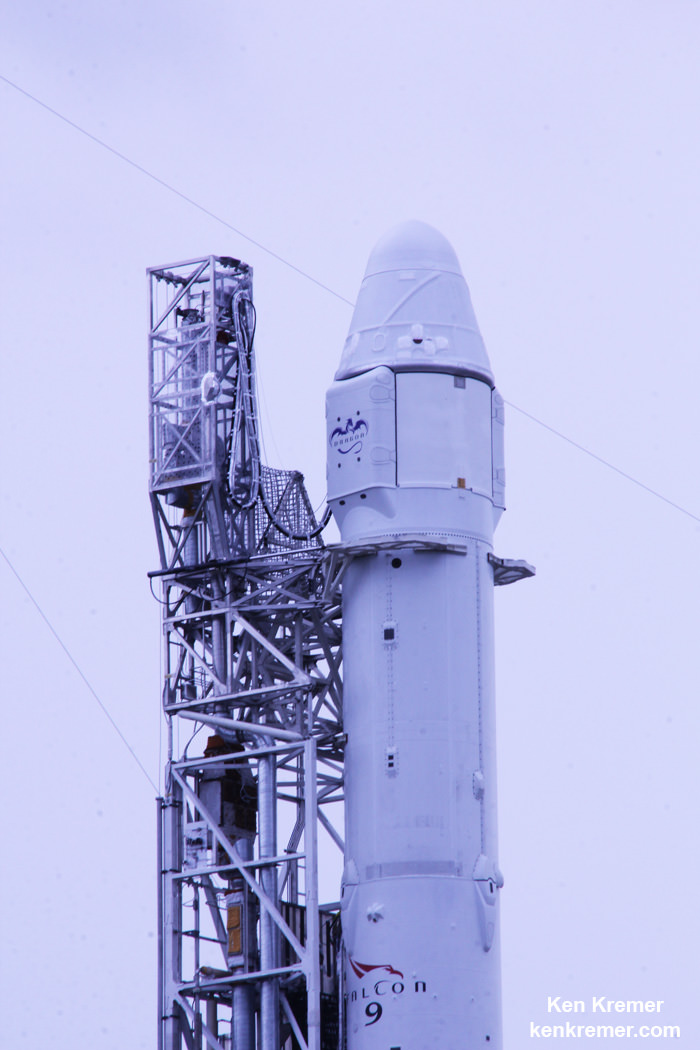
To enable propulsive landings, SpaceX recently conducted hover tests using a Dragon 2 equipped with eight side-mounted SuperDraco engines at their development testing facility in McGregor, TX.
These are “Key for Mars landing,” SpaceX wrote.
“We are closer than ever before to sending American astronauts to Mars than anyone, anywhere, at any time has ever been,” Newman states.
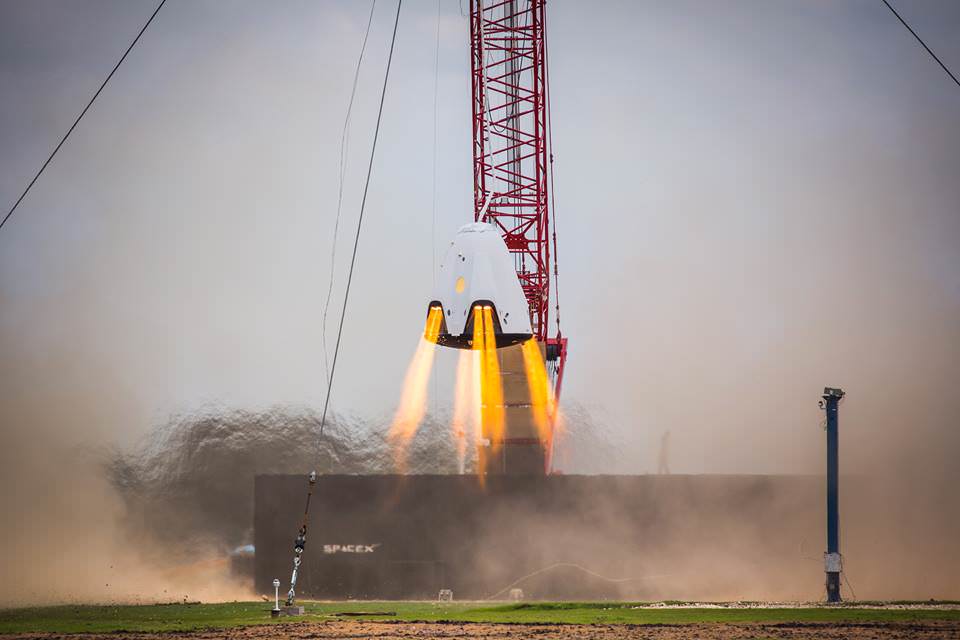
Stay tuned here for Ken’s continuing Earth and planetary science and human spaceflight news.
SpaceX Completes Successful Crew Dragon Test of Astronaut Life Saving Escape System
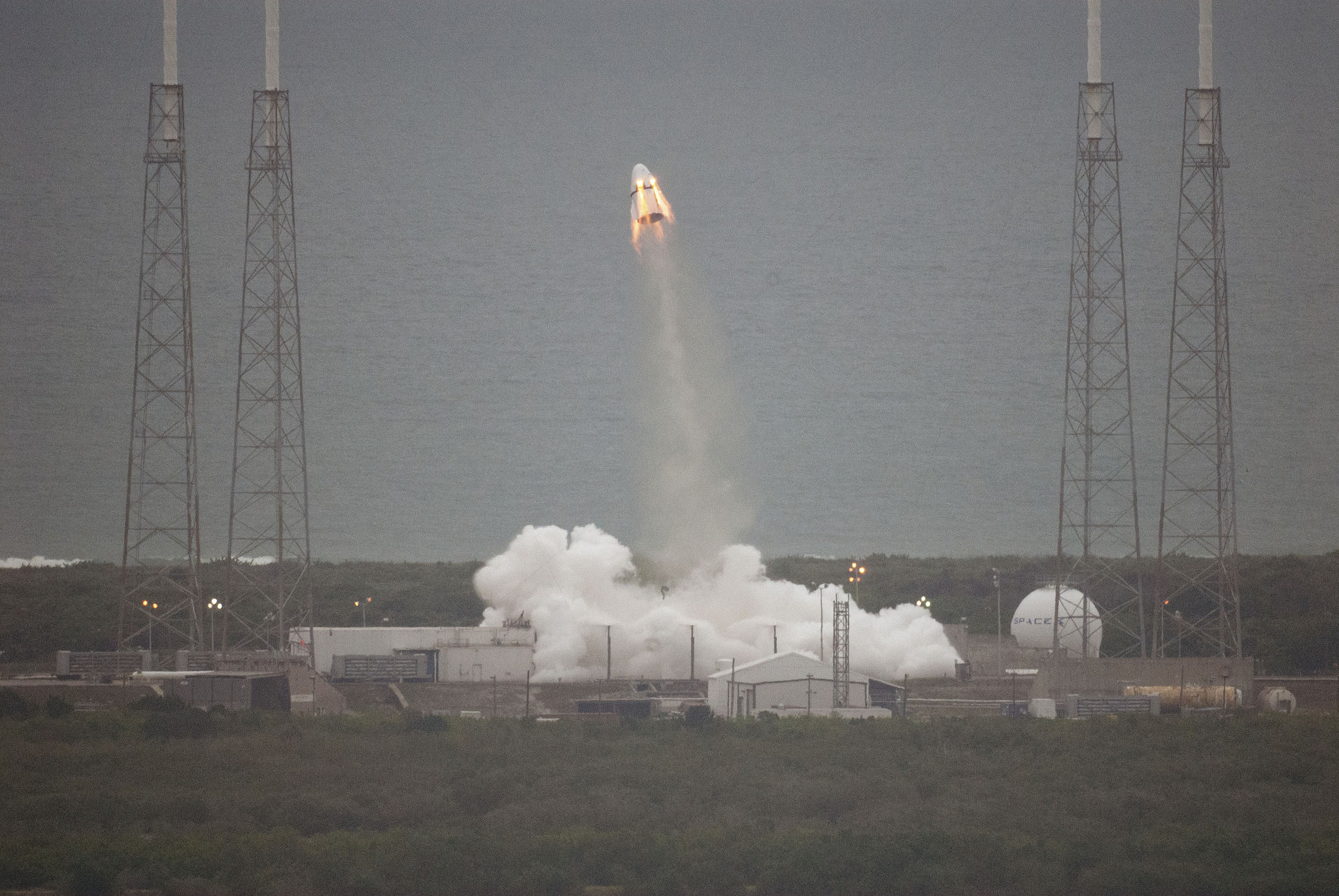
Soaring on the power of an octet of SuperDrago engines, SpaceX successfully completed a critical rapid fire life-saving test of their Dragon crew capsules pad abort emergency escape system that would ignite in a split second to save the astronauts lives in the unlikely event of a failure of the Falcon 9 booster rocket at the Cape Canaveral launch pad.
The uncrewed SpaceX Crew Dragon roared swiftly skywards upon ignition of the test vehicle’s integrated SuperDraco engines at 9 a.m EDT this morning, Wednesday, May 6, for the mile high test conducted from the SpaceX Falcon 9 launch pad from a specially built platform at Space Launch Complex 40 (SLC-40) at Cape Canaveral Air Force Station, Florida.
A human-sized crash test dummy was seated inside for the test exercise which ended safely with a parachute assisted Atlantic Ocean splashdown after less than two minutes. There were no astronauts aboard.
The SuperDraco engines fired for approximately six seconds and accelerated the crew Dragon “from 0 to 100 mph in 1.2 seconds. It reached a top speed of about 345 mph,” said SpaceX CEO Elon Musk in a post test briefing.
“This bodes quite well for the future of the program. I don’t want to jinx it, but this is really quite a good indication for the future of Dragon.” said Elon Musk.
“We hope to launch the first crews to the ISS within about two years, plus or minus six months.”
The side mounted escape engines mark a revolutionary change from the traditional top mounted launch escape system used previously in the Mercury, Apollo, Soyuz and Orion human spaceflight capsules. The space shuttle had no escape system beyond ejections seats used on the first four flights.
Dragon was mounted atop the finned trunk section for the test. The entire Dragon/trunk assembly was about 20 feet (5 meters) tall.
The test is a critical milestone towards the timely development of the human rated Dragon that NASA is counting on to restore the US capability to launch astronauts from US soil abroad US rockets to the International Space Station (ISS) as early as 2017.
“This is a critical step toward ensuring crew safety for government and commercial endeavors in low-Earth orbit,” said Kathy Lueders, manager of NASA’s Commercial Crew Program.
“Congratulations to SpaceX on what appears to have been a successful test on the company’s road toward achieving NASA certification of the Crew Dragon spacecraft for missions to and from the International Space Station.”
Here is a video of the Pad Abort Test:
Video caption: Powered by its SuperDraco engines, the uncrewed SpaceX Crew Dragon flies through its paces in the Pad Abort Test from Cape Canaveral Air Force Station in Florida. Credit: NASA
After all the monomethylhydrazine and nitrogen tetroxide hypergolic propellants were consumed, Dragon soared as planned to an altitude of about 1500 meters (.93 mi) above the launch pad. At about T+21 seconds the trunk was jettisoned and the spacecraft began a slow rotation with its heat shield pointed toward the ground again as it arced out eastwards over the ocean.
The drogue chutes and trio of red and white main parachutes deployed as planned for a picturesque Dragon splashdown in the Atlantic Ocean about a mile offshore of its Cape Canaveral launch pad. The capsule was retrieved from the ocean by waiting recovery boats.
Today’s pad abort demonstration tested the ability of the set of eight SuperDraco engines integrated directly into the side walls of the crew Dragon to ignite simultaneously and pull the vehicle away from the launch pad in a split second – in a simulated emergency to save the astronauts lives in the event of a real emergency.
Therefore the Pad Abort Test did not include an actual Falcon 9 booster since it was focused on a checkout of the capsule’s escape capability.
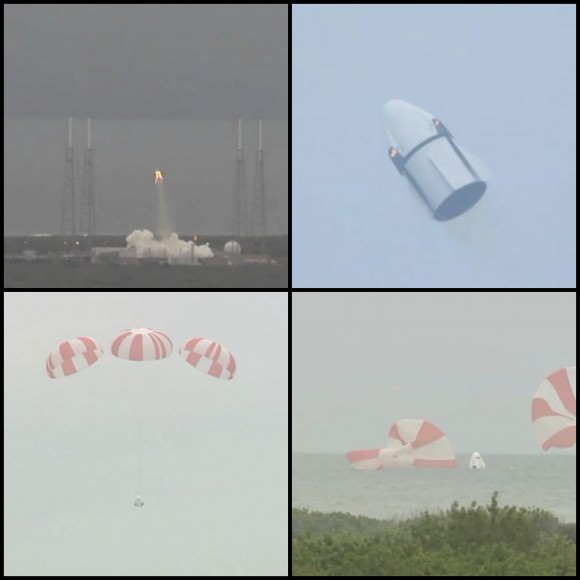
The SuperDraco engines are located in four jet packs built into the capsule around the base. Each engine produces about 15,000 pounds of thrust pounds of axial thrust, for a combined total thrust of about 120,000 pounds in under one second, to propel the astronauts safely away.
The entire test lasted less than two minutes.
The test was webcast live on NASA TV: http://www.nasa.gov/nasatv
The crew Dragon is outfitted with 270 sensors to measure a wide range of vehicle, engine, acceleration and abort test parameters.
The pad abort test was accomplished under SpaceX’s Commercial Crew Integrated Capability (CCiCap) agreement with NASA, that will eventually lead to certification of the Dragon for crewed missions to low Earth orbit and the ISS.
A second Dragon flight test follows later in the year, perhaps in the summer. It will launch from a SpaceX pad at Vandenberg Air Force Base in California and involves simulating an in flight emergency abort scenario during ascent at high altitude at maximum aerodynamic pressure (Max-Q) at about T plus 1 minute, to save astronauts lives.
The pusher abort thrusters would propel the capsule and crew safely away from a failing Falcon 9 booster for a parachute assisted splashdown into the ocean.
“This is what SpaceX was basically founded for, human spaceflight,” said Hans Koenigsmann, vice president of Mission Assurance with SpaceX, at a prelaunch briefing.
“The pad abort is going to show that we’ve developed a revolutionary system for the safety of the astronauts, and this test is going to show how it works. It’s our first big test on the Crew Dragon.”
Stay tuned here for Ken’s continuing Earth and planetary science and human spaceflight news.
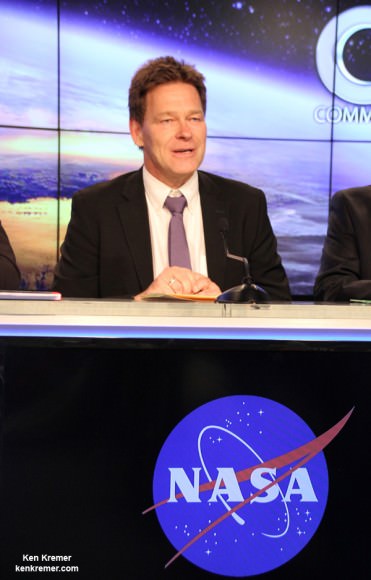
Key Facts and Timeline for SpaceX Crewed Dragon’s First Test Flight May 6 – Watch Live
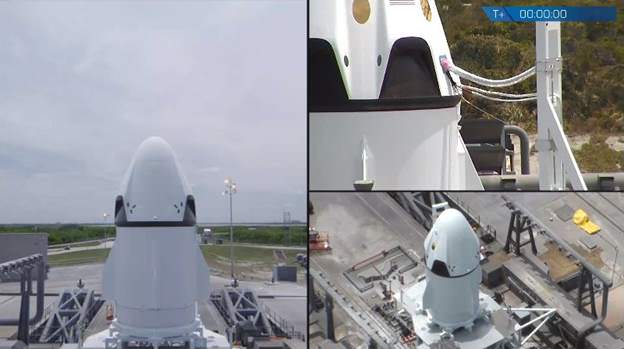
The first critical test flight of SpaceX’s crewed Dragon that will soon launch American astronauts back to orbit and the International Space Station (ISS) from American soil is now less than two days away.
The test flight – called the Pad Abort Test – is slated for the early morning hours of Wednesday, May 6, if all goes well. The key facts and a timeline of the test events are outlined herein.
The test vehicle will reach roughly a mile in altitude (5000 feet, 1500 meters) and last only about 90 seconds in duration from beginning to end.
It constitutes a crucial first test of the crew capsule escape system that will save astronauts lives in a split second in the unlikely event of a catastrophic launch pad failure with the Falcon 9 rocket.
The May 6 pad abort test will be performed from the SpaceX Falcon 9 launch pad from a platform at Space Launch Complex 40 (SLC-40) at Cape Canaveral Air Force Station, Florida. The test will not include an actual Falcon 9 booster.
SpaceX has just released new images showing the Dragon crew capsule and trunk section being moved to the launch pad and being positioned atop the launch mount on SLC-40. See above and below. Together the Dragon assembly stands about 20 feet (5 meters) tall.
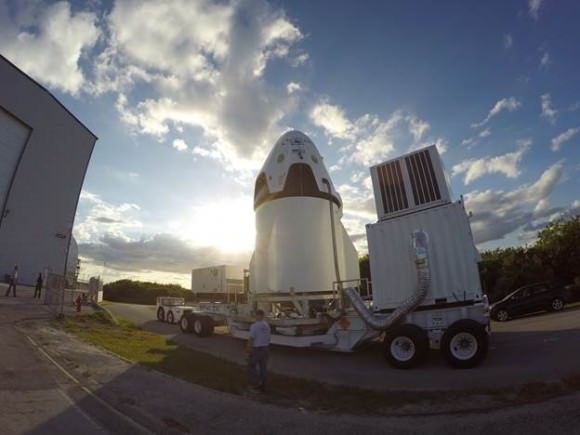
A test dummy is seated inside. And SpaceX now says the dummy is not named “Buster” despite an earlier announcement from the company.
“Buster the Dummy already works for a great show you may have heard of called MythBusters. Our dummy prefers to remain anonymous for the time being,” SpaceX said today.
So, only time will tell if that particular mission fact will ever be revealed.
You can watch the Pad Abort Test via a live webcast on NASA TV: http://www.nasa.gov/nasatv
The test window opens at 7 a.m. EDT May 6 and extends until 2:30 p.m. EDT into the afternoon.
The webcast will start about 20 minutes prior to the opening of the window. NASA will also provide periodic updates about the test at their online Commercial Crew Blog.
The current weather forecast predicts a 70% GO for favorable weather conditions during the lengthy test window.
Since the Pad Abort Test is specifically designed to be a development test, in order to learn crucial things about the performance of the escape system, it doesn’t have to be perfect to be valuable.
And delays due to technical issues are a very significant possibility.
“No matter what happens on test day, SpaceX is going to learn a lot,” said Jon Cowart, NASA’s partner manager for SpaceX at a May 1 media briefing at the Kennedy Space Center press site. “One test is worth a thousand good analyses.”
The test is critical for the timely development of the human rated Dragon that NASA is counting on to restore the US capability to launch astronauts from US soil abroad US rockets to the International Space Station (ISS) as early as 2017.
Here’s a graphic illustrating the May 6 SpaceX Pad Abort Test trajectory and sequence of planned events.
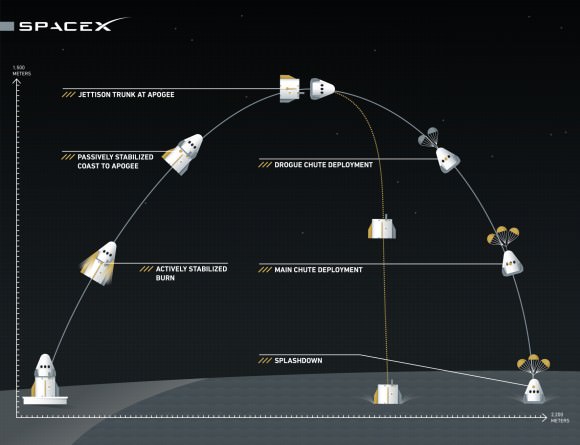
The Crew Dragon will accelerate to nearly 100 mph in barely one second. The test will last less than two minutes and the ship will travel over one mile in the first 20 seconds alone.
The pad abort demonstration will test the ability of a set of eight SuperDraco engines built into the side walls of the crew Dragon to pull the vehicle away from the launch pad in a split second in a simulated emergency to save the astronauts lives in the event of a real emergency.
The SuperDraco engines are located in four jet packs around the base. Each engine produces about 15,000 pounds of thrust pounds of axial thrust, for a combined total thrust of about 120,000 pounds, to carry astronauts to safety.
The eight SuperDraco’s will propel Dragon nearly 100 meters (328 ft) in 2 seconds, and more than half a kilometer (1/3 mi) in just over 5 seconds.
SpaceX likens the test to “an ejection seat for a fighter pilot, but instead of ejecting the pilot out of the spacecraft, the entire spacecraft is “ejected” away from the launch vehicle.”
Here’s a timeline of events from SpaceX:
T-0: The eight SuperDracos ignite simultaneously and reach maximum thrust, propelling the spacecraft off the pad.
T+.5s: After half a second of vertical flight, Crew Dragon pitches toward the ocean and continues its controlled burn. The SuperDraco engines throttle to control the trajectory based on real-time measurements from the vehicle’s sensors.
T+5s: The abort burn is terminated once all propellant is consumed and Dragon coasts for just over 15 seconds to its highest point about 1500 meters (.93 mi) above the launch pad.
T+21s: The trunk is jettisoned and the spacecraft begins a slow rotation with its heat shield pointed toward the ground again.
T+25s: Small parachutes, called drogues, are deployed first during a 4-6 second window following trunk separation.
T+35s: Once the drogue parachutes stabilize the vehicle, three main parachutes deploy and further slow the spacecraft before splashdown.
T+107s: Dragon splashes down in the Atlantic Ocean about 2200 meters (1.4 mi) downrange of the launch pad.
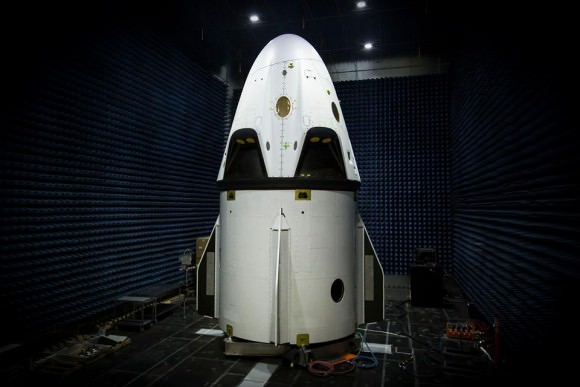
“This is what SpaceX was basically founded for, human spaceflight,” said Hans Koenigsmann, vice president of Mission Assurance with SpaceX.
“The pad abort is going to show that we’ve developed a revolutionary system for the safety of the astronauts, and this test is going to show how it works. It’s our first big test on the Crew Dragon.”
The pusher abort thrusters would propel the capsule and crew safely away from a failing Falcon 9 booster for a parachute assisted splashdown into the Ocean.
Koenigsmann notes that the SpaceX abort system provides for emergency escape all the way to orbit, unlike any prior escape system such as the conventional launch abort systems (LAS) mounted on top of the capsule.
The next Falcon 9 launch is slated for mid-June carrying the CRS-7 Dragon cargo ship on a resupply mission for NASA to the ISS. On April 14, a flawless Falcon 9 launch boosted the SpaceX CRS-6 Dragon to the ISS.
There was no attempt to soft land the Falcon 9 first stage during the most recent launch on April 27. Due to the heavy weight of the TurkmenÄlem52E/MonacoSat satellite there was not enough residual fuel for a landing attempt on SpaceX’s ocean going barge.
The next landing attempt is set for the CRS-7 mission.
Stay tuned here for Ken’s continuing Earth and planetary science and human spaceflight news.
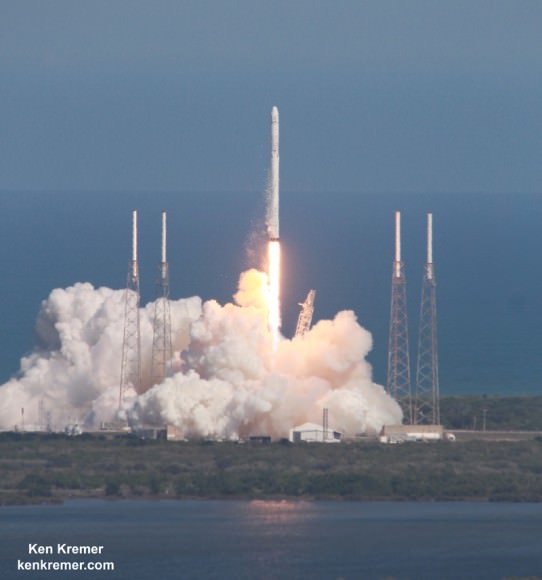
SpaceX Picks Up Launch Pace; Sets April 27 Commercial Launch and May 5 Crew Dragon Pad Abort Test
SpaceX Dragon V2 test flight vehicle set for May 5, 2015 pad abort test. Credit: SpaceX
See below SpaceX live launch webcast link[/caption]
As promised, SpaceX is picking up its launch pace in 2015 with a pair of liftoffs from the Florida space coast slated for the next week and a half. They follow closely on the heels of a quartet of successful blastoffs from Cape Canaveral, already accomplished since January.
If all goes well, a commercial satellite launch and a human spaceflight related pad abort test launch for NASA are scheduled for April 27 and May 5 respectively.
Mondays launch of a communications satellite for Thales Alenia Space takes place just 13 days after SpaceX successfully launching the Dragon CRS-6 resupply freighter to the International Space Station (ISS) for NASA on April 14.
The 13 day turnaround time will mark a new launch cadence record for SpaceX if the weather and rocket cooperate, eclipsing the 14 day turnaround record set last September.
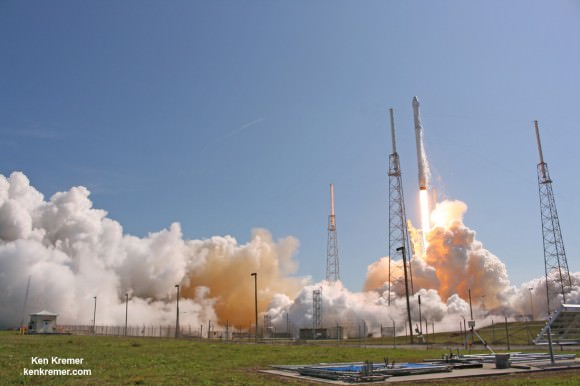
The 224 foot tall SpaceX Falcon 9 rocket is scheduled to launch at approximately 6:14 p.m. EDT (2214 GMT) on April 27 from Space Launch Complex 40 (SLC-40) at Cape Canaveral Air Force Station, Florida. It will deliver the TurkmenÄlem52E/MonacoSat satellite to a geosynchronous transfer orbit.
This first satellite ever for Turkmenistan will be deployed approximately 32 minutes after liftoff of the fifth Falcon 9 rocket this year.
The outlook is currently 60 percent GO for favorable weather conditions at launch time.
You can watch the launch live via a SpaceX webcast that begins about 20 minutes before launch at: spacex.com/webcast
The May 5 pad abort test for NASA is critical for the timely development of the human rated Dragon that NASA is counting on to restore the US capability to launch astronauts from US soil to the space station.
The test will simulate an emergency abort from a test stand and will also take place from the Cape’s Space Launch Complex 40 in Florida.
SpaceX has a four hour launch window in which to conduct the test. The test window opens at 9:30 a.m. EDT (1330 GMT) on May 5. There is a backup opportunity on May 6.
The pad abort demonstration will test the ability of a set of eight SuperDraco engines built into the side walls of the crew Dragon to pull the vehicle away from the launch pad in a split second in a simulated emergency.
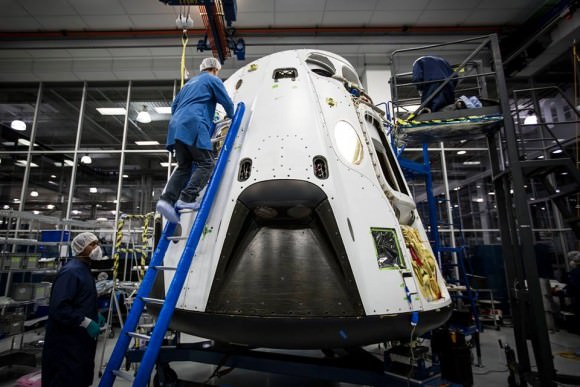
The purpose is to test the ability of the abort system to save astronauts lives in the event of a real emergency.
The SuperDraco engines are located in four jet packs around the base. Each enigne can produce up to 120,000 pounds of axial thrust to carry astronauts to safety, according to a SpaceX description.
Here is a SpaceX video of SuperDraco’s being hot fire tested in Texas.
Video caption: Full functionality of Crew Dragon’s SuperDraco jetpacks demonstrated with hotfire test in McGregor, TX. Credit: SpaceX
The pad abort test is being done under SpaceX’s Commercial Crew Integrated Capability (CCiCap) agreement with NASA.
The initial pad abort test will test the ability of the full-size Dragon to safely push away and escape in case of a failure of its Falcon 9 booster rocket in the moments around launch, right at the launch pad.
“The purpose of the pad abort test is to demonstrate Dragon has enough total impulse (thrust) to safely abort,” SpaceX spokeswoman Emily Shanklin informed me.
For that test, Dragon will use its pusher escape abort thrusters to lift the Dragon safely away from the failing rocket.
The vehicle will be positioned on a structural facsimile of the Dragon trunk in which the actual Falcon 9/Dragon interfaces will be represented by mockups. The test will not include an actual Falcon 9 booster.
A second Dragon flight test follow later in the year. It involves simulating an in flight emergency abort scenario during ascent at high altitude at maximum aerodynamic pressure at about T plus 1 minute, to save astronauts lives. The pusher abort thrusters would propel the capsule and crew safely away from a failing Falcon 9 booster for a parachute assisted landing into the Atlantic Ocean.
The SpaceX Dragon V2 and Boeing CST-100 vehicles were selected by NASA last fall for further funding under the auspices of the agency’s Commercial Crew Program (CCP), as the worlds privately developed spaceships to ferry astronauts back and forth to the International Space Station (ISS).
Both SpaceX and Boeing plan to launch the first manned test flights to the ISS with their respective transports in 2017.
During the Sept. 16, 2014 news briefing at the Kennedy Space Center, NASA Administrator Charles Bolden announced that contracts worth a total of $6.8 Billion were awarded to SpaceX to build the manned Dragon V2 and to Boeing to build the manned CST-100.
There will be no attempt to soft land the Falcon 9 first stage during the April 27 launch. The next landing attempt is set for mid-June.
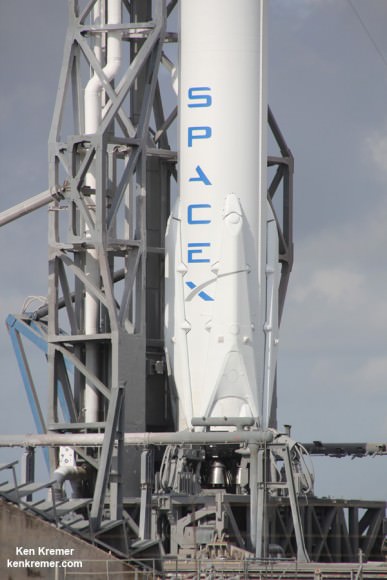
Stay tuned here for Ken’s continuing Earth and planetary science and human spaceflight news.
Weekly Space Hangout – May 30, 2014: Gamma Ray Burst? Maybe Not?
Host: Fraser Cain (@fcain)
Guests: Morgan Rehnberg (cosmicchatter.org / @cosmic_chatter), Brian Koberlien (@briankoberlein)
Continue reading “Weekly Space Hangout – May 30, 2014: Gamma Ray Burst? Maybe Not?”

